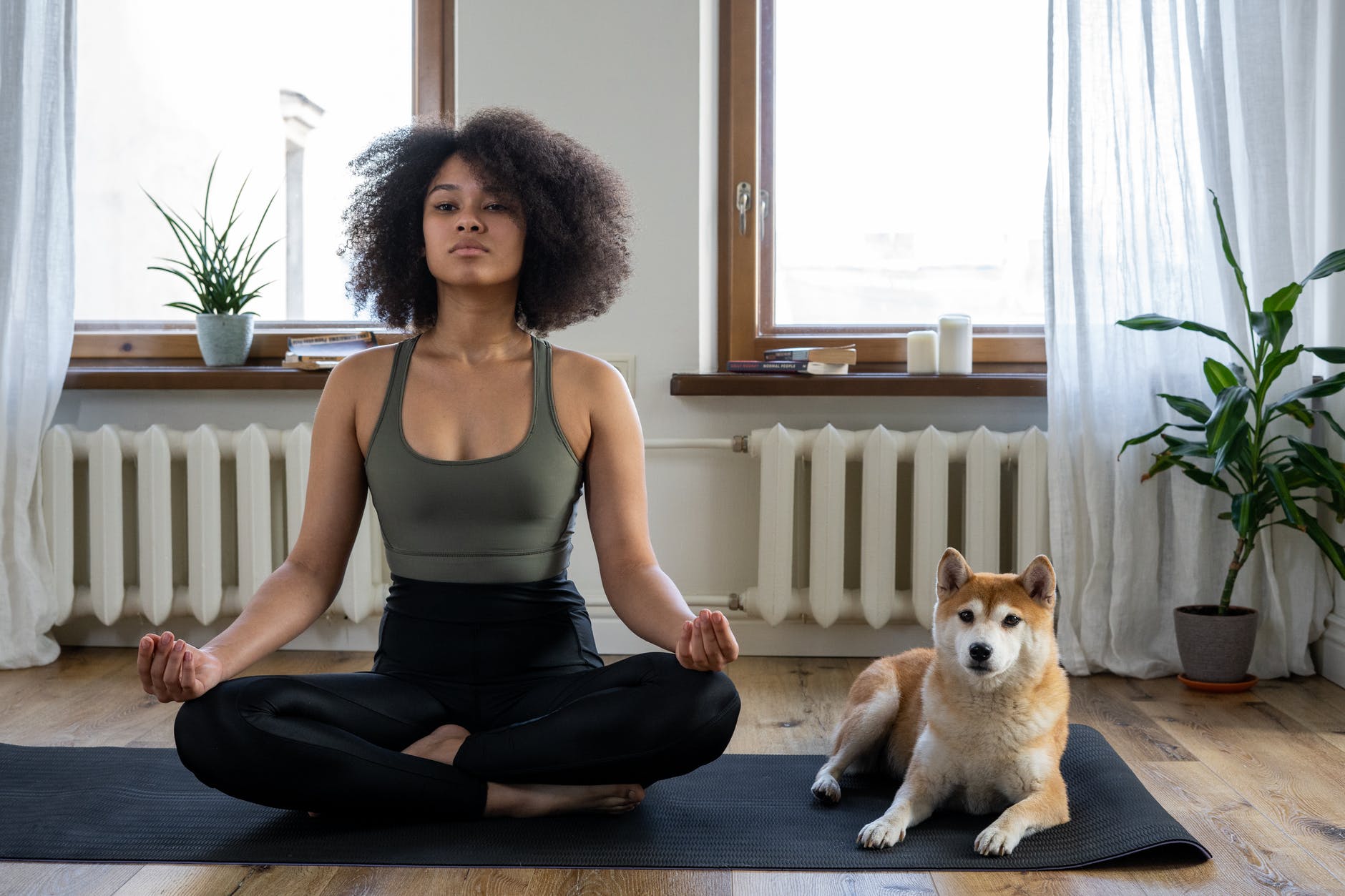
Photo by cottonbro on <a href="https://www.pexels.com/photo/woman-girl-animal-dog-4056535/" rel="nofollow">Pexels.com</a>
You want to work out, whether to get fit or to improve your mental health. However, you don’t want to join the gym or head to exercise classes. Maybe it’s too expensive, there’s no gym near you, or you feel embarrassed working out in front of other people. Maybe your schedule is too packed to allow for trips to the gym. This leaves working out at home. Can you really get an effective workout at home?
For most of us, we just don’t have time to go to the gym every day, and for effective fitness, consistency is key. By working out at home you adopt fitness as a lifestyle, making it easier to keep up.
It doesn’t need to take much effort or money to design an effective workout program that you can without leaving the house. With things like YouTube videos, online fitness courses like an Openfit fitness class, fit balls, dumbbells, exercise bands, push-up bars, you can create a routine that will work for all your major muscle groups.
Even with no props, you can still build muscle and burn calories. If you’re just getting started, you could go for a brisk walk, followed by some ab exercises and push-ups.
Elements Of Fitness
The most effective fitness programs have five components, all of which can be done easily at home:
- A warmup
- A cardiovascular (aerobic) workout
- Resistance (strength-building) exercises
- Flexibility moves
- A cooldown
Your warm could be a gentle walk outside or on your treadmill, or a slow pace on a stationary bike. For cardiovascular exercise, walk or pedal faster, do a step aerobics video, or jump rope. You just need to get your heart rate up.
The resistance part can be something simple like squats, push-ups, and ab exercises, or you could use dumbbells, a weight bar, or resistance bands.
You can work on your flexibility with some floor stretches or yoga poses. Your cooldown ought to be similar to your warmup. Do cardiovascular work at a low level to being your heart rate back down to a resting state.
You can combine strength and aerobic work into one workout, or do them separately. Just make sure you always warm-up and cool down whenever you exercise, to avoid injury.
If you’re pressed for time, you can just increase the intensity of your workout. Instead of 45 minutes on the stationary bike at a leisurely pace, ride hard for 25 minutes. Choose a hilly place to walk, or jog instead of your walk.
Step up the pace of a strength workout with compound exercises. Compound exercises work more than one muscle group at a time. For example, you could do squats to work the quadriceps, hamstrings, glutes, and calves. Push-ups use your pectorals, deltoids, biceps, triceps, abs, and upper back.
If you’re not sure how to create your own workout, there are thousands of fitness videos, whether online or on DVD, that offer everything from Zumba to Yoga to Karate. Make sure you choose one that is suitable for your level of fitness.
Image – free for commercial use
Getting Started
If you’re new to exercise, start out by aiming for 30 minutes of cardiovascular exercises at least three times a week, and 20 to 30 minutes of strength exercise three times a week. Your strength workout should cover all the major muscle groups, in your upper body, lower body, abdominals, and back. Aim for three sets of 10 to 15 reps for each strength exercise you do.
Whatever kind of exercise you choose to do, make sure you start out slowly and gradually increase the intensity and length of your workouts. Listen to your body. Focus on the muscles that you think should be working. Can you feel it in the right place? If you’re working your abs, but can feel it in your neck, you’re doing it wrong. Tune into your body.
You should also pay close attention to what makes you feel motivated to work out.
There are lots of obvious advantages to working out at home, especially for busy people, but there are a few obstacles as well. There can be a lot of distractions when you work out at home. The phone rings, the kids are squabbling, the dog wants to lie on your exercise mat, your spouse can’t find the big saucepan to get dinner started. If you’re interrupted during your workout by distractions like this, it can derail your whole workout and make it hard to get back on track. This assumes that you have managed to get started on the workout in the first place. When you’re working at home, it can be all too easy to find something else that needs to be done, like starting dinner, doing the laundry, or helping the kids with homework.
An effective way to stay motivated and avoid distractions is to get your workout down early in the day. Those who work out in the morning are a lot more likely to stick to their workouts before the demands of home and family get in the way. Get it done early, and the rest of your day is yours.
Tips For Home Exercisers
If you want to try exercise at home, try some of these tips to make your workouts effective, and to help you stay motivated and free from injuries.
- Challenge yourself to avoid getting bored. If you do your workouts at home, you aren’t going to be able to get the variety of equipment and classes that would be available at the gym. To avoid getting bored of doing the same things all the time, you can get online or look through fitness magazines to get ideas for new workouts and make sure you’re doing your exercises correctly. Pictures and video can be very helpful for the home exerciser. Use them as a guide to check your form and technique to avoid getting injured.
- Find an exercise partner. It’s a lot harder to find excuses to skip your workout when you’ve promised to work out with someone else. Get your spouse or a friend involved to keep you both accountable.
- Schedule your workouts. It can help a lot to have a plan. Buy a planner, use the calendar, or use your phone, and write your exercise in as an appointment well in advance, the same way as you would any other appointment, like taking the kids to football, or going to the dentists. If something comes up, and you need to change a workout, rearrange it, don’t just abandon it. Having the time blocked out will help you actually do it, and shows your commitment. Putting your workouts on the calendar also shows the family that you are not available at this time, just as you wouldn’t be on hand to help find that lost you if you were booked in for anything else.
- Use a journal to track your progress. You should record any breakthroughs that you might have along the way. If you have a bad day, record that too. This will help you to find patterns that you can break or make use of. For example, if you felt lethargic during a few workouts, and can see that happened on days when you skipped breakfast, then you know not to do that anymore. Writing things down might show you that your workouts are better after you’ve eaten eggs for breakfast, rather than a bagel, for example. Tracking your progress can also help you to feel more motivated. For example, if you can see that you’re able to do more push-ups than you could a month ago, that’s progress to feel proud of and to motivate you to improve even more.
- Set goals. Make these tangible and realistic, such as training for a race or losing ten pounds. The best goals to set are something that you aren’t able to do right now, but that you think is within your reach. If your goal is too easy to too hard, you won’t feel motivated by it. You can break a larger goal up into smaller pieces, and give yourself mini-rewards along the way. For example, if your goal is to be able to a certain number of pull-ups, every time you achieve a few more, give yourself a small reward, like a magazine, new workout clothes, or a new piece of equipment.
- One of the most important tips to help you commit to your workout routine at home is to make exercise an integral part of your life and daily routine, as much as eating and sleeping. You should think of this as a lifestyle change, not a temporary change. Get out of the mindset that exercise is something that will only be doing for a little while just to reach a goal. Make your workouts part of your routine, and make being more physically active part of life, such as taking a walk after work with your spouse, cycling with the family at weekends, or walking the dog every morning.


